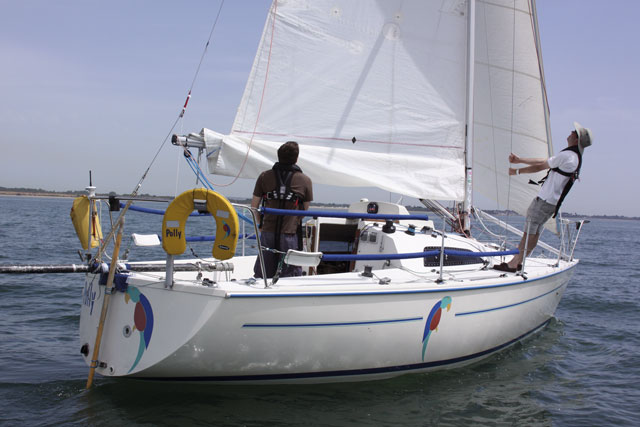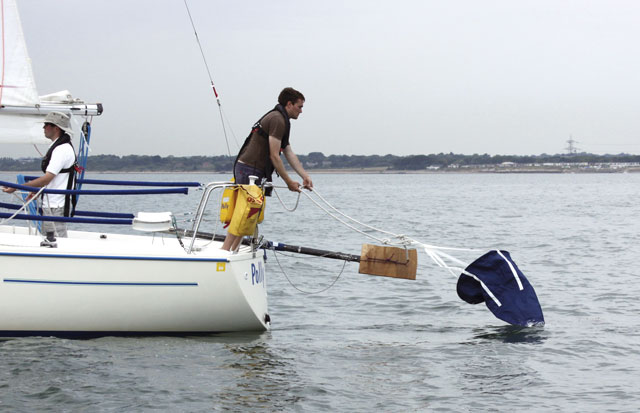How would you cope if your boat lost its steering at sea? PBO tries a variety of jury steering fixes to see how well they help to regain control
‘At 0300 we gybed to lay the finish. J-Fever slewed across the wind and failed to come back on course. A glance back at skipper on the helm saw him twiddling the wheel, pressing autopilot buttons and peering into the after locker before announcing that he thought the rudder had gone….’
Luckily, this crew made it safely back to Cherbourg in October 2010. But as they found out, losing the ability to steer at sea is a terrifying prospect. Your boat, once set firm on her course, is now at the mercy of wind and waves until you can make some sort of repair. But what can you do to self-rescue and make it to safety? Most people will have given a cursory glance at their emergency tiller or at a textbook, but if it happened, would you know what to do?
PBO took to the water twice to find out – once with no rudder and again to try and steer with an emergency tiller. We learned a lot!
They say you should face bad news first, so the first thing to do was to simulate complete, catastrophic rudder loss. Of course, the only way to simulate rudder loss was to remove the rudder entirely. My boat, Polly, has a transom-hung rudder, so apparently it fell to me to volunteer the boat. Gulp.
Discretion is sometimes better than valour so we opted to rig the most complex of our jury steering ideas on the mooring before heading out into the Solent to give it a try. We could then break it down piece by piece to eventually end up with no rudder at all.
Rudderless
Prompted by PBO’s technical editor, David Harding, we thought that a skeg, however small, might help us maintain our course. This could be lashed to a backstay or transom fitting. So we unshipped Polly’s rudder and lashed a dinghy oar to the gudgeons with the blade under water aligned fore and aft.
We then added our jury rudder. I’m sure you’ve seen the textbooks that suggest lashing a locker door to a spinnaker pole and using it over the transom as a sweep. We cut a piece of plywood to the size of one of Polly’s locker lids and used an elderly Firefly boom, the same length as her spinnaker pole, lashing it over the transom between two pushpit legs and the two mooring fairleads.
Conscious of Polly’s painted topsides and gel coat, I taped some old carpet to the pole and the transom. In an emergency, a fender or berth cushion would suffice. Finally, we added another lashing from the bottom gudgeon to the blade at waterline level to keep it submerged.
Our photographer Eddie Mays then gave us an alongside tow out into open water and cast us off. I must admit to a feeling of trepidation – was this wise? With 10-15 knots of breeze, we reefed right down to three reefs and a No4 jib to get the boat under control and tried out the first of our jury steering methods.
Best way to steer a yacht without a rudder: Skeg and Viking Oar

The best solution: skeg and oar. A lashing holding the blade in the water made it much easier to handle
The sweep and skeg combination was amazingly effective, giving positive steering with relatively light loads on the tiller. With our modest sailplan we had perfect directional control, and the lower lashing kept the blade both in the water and vertical. We could go upwind as normal, tack and gybe, and maintain a course.
The advantages of the skeg were twofold. It reduced the load on the sweep and gave the boat some directional stability even when, going over a wave, the sweep blade came perilously close to the surface. Best of all, it gave another pivot point to stop the sweep from loosening its own lashings, which periodically needed tightening with a variety of hitches and frappings.
Steering a yacht without a rudder – Skeg tested (on its own)

The skeg would allow you to regain some control while you think about how to rig a more positive steering system
The next step was to release the lower lashing and lift the Viking oar out of the water. We hoped that the skeg would give us enough directional stability that, with a responsive boat such as Polly, we would be able to steer using the sails and crew weight alone.
We sheeted in to find out. Polly had a tendency to respond to every gust or wave with a course alteration, but by using the sails – jib in and weight to windward to bear away, main in and weight to leeward to head up – we could keep her on a good course. It’s not a long-term plan or one for congested waters, but it was good to know that a simple method such as this could keep her under control or sail her out of danger while we rigged another, more positive steering method.
Real-life experience
PBO web forum user Nicholas49 has a tale to tell: ‘600 miles from land, returning from the Jester Azores Challenge in 2008, the rudder shaft snapped. We tried a washboard bolted to the spinnaker pole, but in rough weather you’d need 10 Vikings to hold it.
‘We then tried using the sea-anchor: this was a little better, but not much. It shredded itself, and we didn’t notice it had gone. Wind increased to Force 7-8 and from then on we kept going by various adjustments of the storm jib, doing 30-40 miles a day until we got to the continental shelf. It then calmed down and we were able to fit the spinnaker pole rudder with two straps from the bottom of the shaft to the genoa winches, which gave it forward support. With this lash-up, we were able to sail to the Isles of Scilly successfully.’
Jury rudder review: Viking oar tested (without skeg)
Next, we removed the skeg and lowered the sweep back into the water to see if Polly was still easy to steer. The method worked, but the jury sweep was under significantly higher loads and constantly tried to rotate and remove itself from the water. This quickly became tiring, and on a reach the gusts would require a strong hand on the sweep to bring Polly back on her course. A longer pole would have helped here, but without taking the main boom off there was nothing of a suitably longer length on board. It really showed the importance of balancing the sails as much as possible to reduce the load on the temporary oar. If at sea or on a long passage, steering lines leading athwartships would allow you some rest.
Viking oar: the verdict
The sweep was successful in giving us steering again, although it would be hard to control in big waves. In flat and congested waters with small sail, it gave us good control. In fact, we felt so confident in controlling the boat that we motored up the river and came alongside using it to steer, with a RIB standing by. Photographer Eddie looked bored – he wasn’t needed, as we motored slowly up river and came alongside with the fenders barely kissing the pontoon. In stronger winds or lumpier waters, the addition of the skeg adds valuable extra directional stability.
Sailing rudderless
Finally, we tilted the sweep out of the water and tried to sail Polly without skeg or rudder. She wasn’t happy. With no skeg or anything aft of the fin keel, she refused to maintain any kind of course. Gradually, with constant tweaking of the main and jib sheets and judicious movement of our weight, we managed to get her to head in roughly the right direction, tack and gybe – but all of these were in the flat waters of the Solent on a weekday with only a few other boats around.

Eventually, by moving our weight and trimming sails, the PBO steering committee regained control of the boat
Tried and tested: Using a drogue to steer a rudderless yacht
J-Fever, the boat you read about earlier, regained control and successfully entered Cherbourg Harbour in a strong following breeze and with large waves. Her crew used a drogue, which is a tried and tested method of jury steering. The Corby 34 Oxygen III lost her rudder in the Round the Island Race this year and made it home safely using the same system, so it sounded like a good thing to have on board.
Our drogue was a Plastimo one which we rigged from amidships, using blocks attached to the stanchion bases and our longest mooring warps. This gave us some steering, although it was slow going in under 10 knots of breeze. As soon as it picked up to 15 knots, we were off. This felt a safe and secure way to regain steering.
Our lines, however, weren’t quite long enough, or led far enough forward, but we could still hold a course, even upwind, with the breeze at 50° off the bow. Gybing was impossible until we moved the drogue leads further forward so that the boat could pivot around her keel more easily. We sailed about for a while with these tweaks, even managing a cup of tea and a sandwich.
Drogue Verdict
Using a drogue is a tried and tested way of steering. It might be slow, but with long enough lines it will work in big seas and should get you close enough to land to be able to arrange a tow. It’s worth making sure you buy the best quality drogue you can afford, however – stories abound of cheap drogues simply shredding as the loads increase. A sturdy bucket, or even streaming warps, would work to some extent if you had no drogue.
OceanSteer emergency rudder on test
You can read our test of the OceanSteer emergency rudder, another option, here.








